测开学习DAY27
尚硅谷网课学习(shell)
第1章 Shell概述
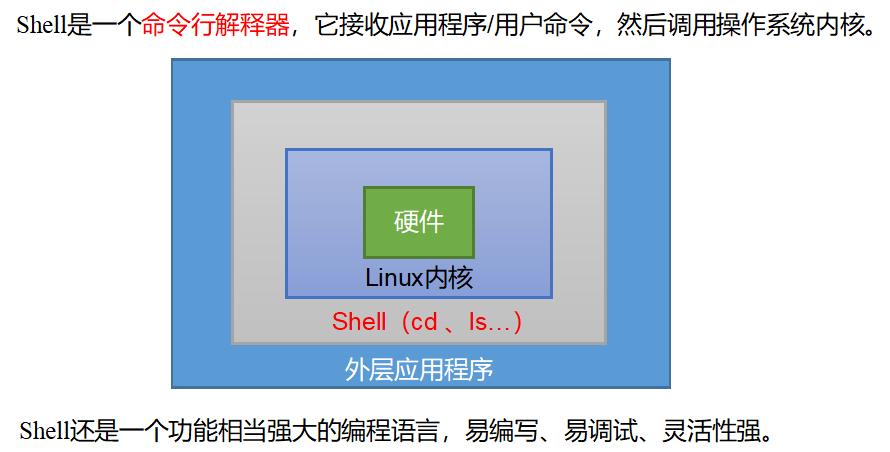 第2章 Shell解析器
第2章 Shell解析器
1. Linux提供的Shell解析器
[atguigu@hadoop101 ~]$ cat /etc/shells
/bin/sh
/bin/bash
/sbin/nologin
/bin/dash
/bin/tcsh
/bin/csh2. bash和sh的关系
[atguigu@hadoop101 bin]$ ll | grep bash
-rwxr-xr-x. 1 root root 941880 5月 11 2016 bash
lrwxrwxrwx. 1 root root 4 5月 27 2017 sh -> bash3. Centos默认的解析器是bash
atguigu@hadoop102 bin]$ echo $SHELL
/bin/bash第3章 Shell脚本入门
1.脚本格式
脚本以#!/bin/bash开头(指定解析器)
2.第一个Shell脚本:helloworld
(1)需求:创建一个Shell脚本,输出helloworld
(2)案例实操:
[atguigu@hadoop101 datas]$ touch helloworld.sh
[atguigu@hadoop101 datas]$ vi helloworld.sh在helloworld.sh中输入如下内容
#!/bin/bash
echo "helloworld"(3)脚本的常用执行方式
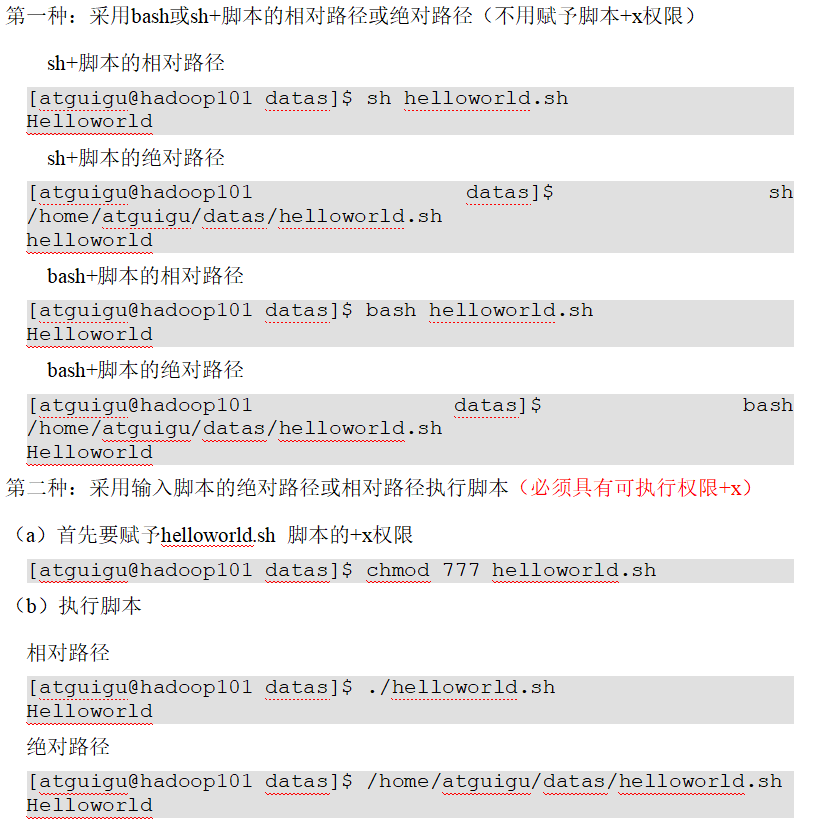
注意:第一种执行方法,本质是bash解析器帮你执行脚本,所以脚本本身不需要执行权限。第二种执行方法,本质是脚本需要自己执行,所以需要执行权限。
3.第二个Shell脚本:多命令处理
(1)需求:
在/home/atguigu/目录下创建一个banzhang.txt,在banzhang.txt文件中增加“I love cls”。
(2)案例实操:
[atguigu@hadoop101 datas]$ touch batch.sh
[atguigu@hadoop101 datas]$ vi batch.sh在batch.sh中输入如下内容
#!/bin/bashcd /home/atguigu
touch cls.txt
echo "I love cls" >>cls.txt第4章 Shell中的变量
1. 系统变量
1. 常用系统变量
$HOME、$PWD、$SHELL、$USER等
2.案例实操
(1)查看系统变量的值
[atguigu@hadoop101 datas]$ echo $HOME
/home/atguigu(2)显示当前Shell中所有变量:set
[atguigu@hadoop101 datas]$ set
BASH=/bin/bash
BASH_ALIASES=()
BASH_ARGC=()
BASH_ARGV=()2. 自定义变量
1.基本语法
(1)定义变量:变量=值
(2)撤销变量:unset 变量
(3)声明静态变量:readonly变量,注意:不能unset
2.变量定义规则
(1)变量名称可以由字母、数字和下划线组成,但是不能以数字开头,环境变量名建议大写。
(2)等号两侧不能有空格
(3)在bash中,变量默认类型都是字符串类型,无法直接进行数值运算。
(4)变量的值如果有空格,需要使用双引号或单引号括起来。
3.案例实操
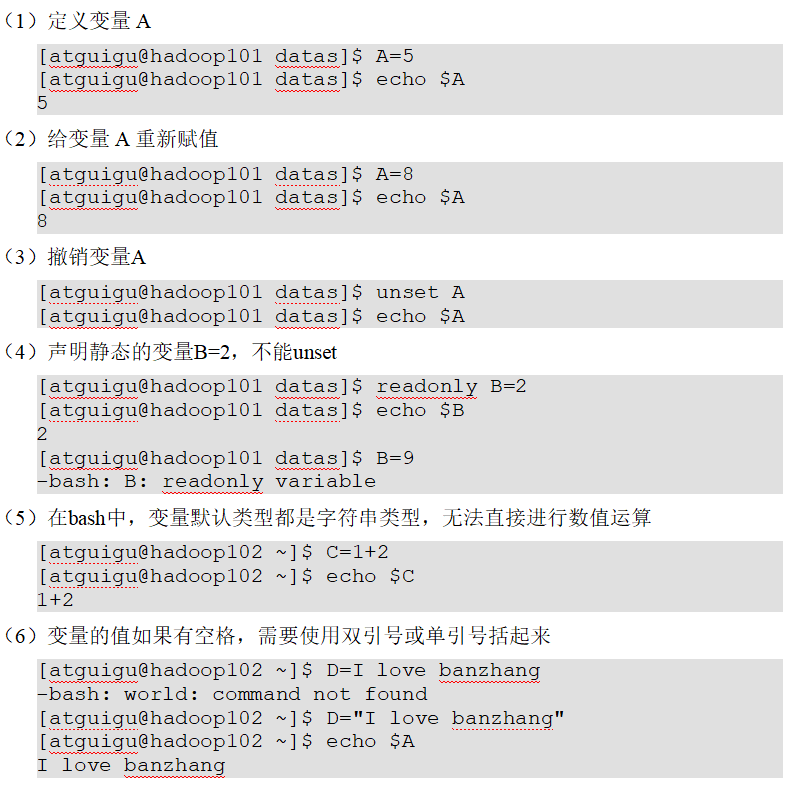 (7)可把变量提升为全局环境变量,可供其他Shell程序使
(7)可把变量提升为全局环境变量,可供其他Shell程序使
export 变量名
[atguigu@hadoop101 datas]$ vim helloworld.sh 在helloworld.sh文件中增加echo $B
#!/bin/bashecho "helloworld"
echo $B[atguigu@hadoop101 datas]$ ./helloworld.sh
Helloworld发现并没有打印输出变量B的值
[atguigu@hadoop101 datas]$ export B
[atguigu@hadoop101 datas]$ ./helloworld.sh
helloworld
23. 特殊变量:$n
1.基本语法
$n (功能描述:n为数字,$0代表该脚本名称,$1-$9代表第一到第九个参数,十以上的参数,十以上的参数需要用大括号包含,如${10})
2.案例实操
输出该脚本文件名称、输入参数1和输入参数2 的值
[atguigu@hadoop101 datas]$ touch parameter.sh
[atguigu@hadoop101 datas]$ vim parameter.sh#!/bin/bash
echo "$0 $1 $2"[atguigu@hadoop101 datas]$ chmod 777 parameter.sh[atguigu@hadoop101 datas]$ ./parameter.sh cls xz
./parameter.sh cls xz4. 特殊变量:$#
1.基本语法
$# (功能描述:获取所有输入参数个数,常用于循环)。
2.案例实操
获取输入参数的个数
[atguigu@hadoop101 datas]$ vim parameter.sh#!/bin/bash
echo "$0 $1 $2"
echo $#[atguigu@hadoop101 datas]$ chmod 777 parameter.sh[atguigu@hadoop101 datas]$ ./parameter.sh cls xz
parameter.sh cls xz
25. 特殊变量:$*、$@
1.基本语法
$* (功能描述:这个变量代表命令行中所有的参数,$*把所有的参数看成一个整体)
$@ (功能描述:这个变量也代表命令行中所有的参数,不过$@把每个参数区分对待)
2.案例实操
打印输入的所有参数
[atguigu@hadoop101 datas]$ vim parameter.sh#!/bin/bash
echo "$0 $1 $2"
echo $#
echo $*
echo $@[atguigu@hadoop101 datas]$ bash parameter.sh 1 2 3
parameter.sh 1 2
3
1 2 3
1 2 36. 特殊变量:$?
1.基本语法
$?(功能描述:最后一次执行的命令的返回状态。如果这个变量的值为0,证明上一个命令正确执行;如果这个变量的值为非0(具体是哪个数,由命令自己来决定),则证明上一个命令执行不正确了。)
2.案例实操
判断helloworld.sh脚本是否正确执行
[atguigu@hadoop101 datas]$ ./helloworld.sh
hello world
[atguigu@hadoop101 datas]$ echo $?
0第5章 运算符
1.基本语法
(1)“$((运算式))”或“$[运算式]”
(2)expr + , - , \*, /, % 加,减,乘,除,取余
注意:expr运算符间要有空格
2.案例实操

第6章 条件判断
1.基本语法
[ condition ](注意condition前后要有空格)
注意:条件非空即为true,[ atguigu ]返回true,[] 返回false。
2. 常用判断条件
(1)两个整数之间比较
= 字符串比较
-lt 小于(less than) -le 小于等于(less equal)
-eq 等于(equal) -gt 大于(greater than)
-ge 大于等于(greater equal) -ne 不等于(Not equal)
(2)按照文件权限进行判断
-r 有读的权限(read)
-w 有写的权限(write)
-x 有执行的权限(execute)
(3)按照文件类型进行判断
-f 文件存在并且是一个常规的文件(file)
-e 文件存在(existence)
-d 文件存在并是一个目录(directory)
3.案例实操
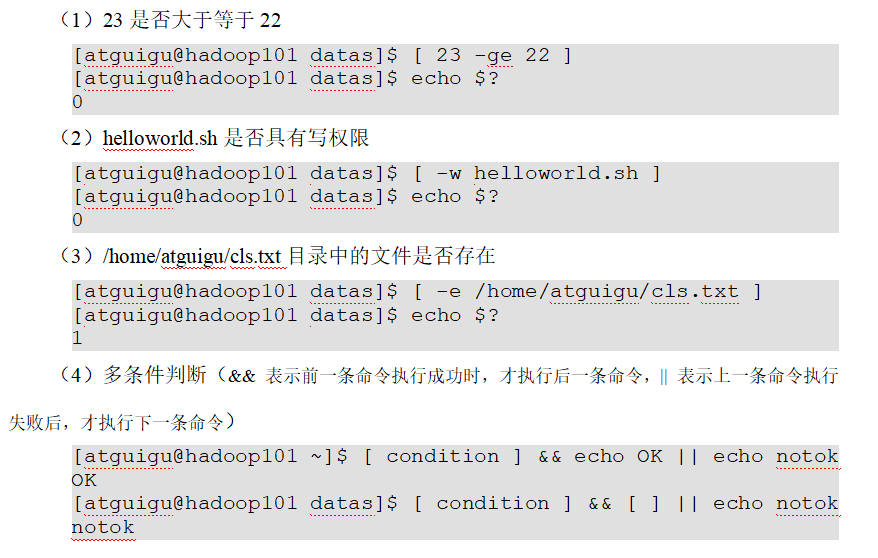
第7章 流程控制(重点)
1. if 判断
1.基本语法

注意事项:
(1)[ 条件判断式 ],中括号和条件判断式之间必须有空格
(2)if后要有空格
2.案例实操
输入一个数字,如果是1,则输出banzhang zhen shuai,如果是2,则输出cls zhen mei,如果是其它,什么也不输出。
[atguigu@hadoop101 datas]$ touch if.sh
[atguigu@hadoop101 datas]$ vim if.sh#!/bin/bashif [ $1 -eq "1" ]
thenecho "banzhang zhen shuai"
elif [ $1 -eq "2" ]
thenecho "cls zhen mei"
fi[atguigu@hadoop101 datas]$ chmod 777 if.sh
[atguigu@hadoop101 datas]$ ./if.sh 1
banzhang zhen shuai2. case 语句
1.基本语法

注意事项:
(1)case行尾必须为单词“in”,每一个模式匹配必须以右括号“)”结束。
(2)双分号“;;”表示命令序列结束,相当于java中的break。
(3)最后的“*)”表示默认模式,相当于java中的default。
2.案例实操
输入一个数字,如果是1,则输出banzhang,如果是2,则输出cls,如果是其它,输出renyao。
[atguigu@hadoop101 datas]$ touch case.sh
[atguigu@hadoop101 datas]$ vim case.sh!/bin/bashcase $1 in
"1")echo "banzhang"
;;"2")echo "cls"
;;
*)echo "renyao"
;;
esac[atguigu@hadoop101 datas]$ chmod 777 case.sh
[atguigu@hadoop101 datas]$ ./case.sh 1
13. for 循环
1.基本语法1

2.案例实操
从1加到100
[atguigu@hadoop101 datas]$ touch for1.sh
[atguigu@hadoop101 datas]$ vim for1.sh#!/bin/bashs=0
for((i=0;i<=100;i++))
dos=$[$s+$i]
done
echo $s[atguigu@hadoop101 datas]$ chmod 777 for1.sh
[atguigu@hadoop101 datas]$ ./for1.sh
“5050”3.基本语法2

4.案例实操
(1)打印所有输入参数
[atguigu@hadoop101 datas]$ touch for2.sh
[atguigu@hadoop101 datas]$ vim for2.sh#!/bin/bash
#打印数字for i in $*doecho "ban zhang love $i "done[atguigu@hadoop101 datas]$ chmod 777 for2.sh
[atguigu@hadoop101 datas]$ bash for2.sh cls xz bd
ban zhang love cls
ban zhang love xz
ban zhang love bd(2)比较$*和$@区别
(a)$*和$@都表示传递给函数或脚本的所有参数,不被双引号“”包含时,都以$1 $2 …$n的形式输出所有参数。
[atguigu@hadoop101 datas]$ touch for.sh
[atguigu@hadoop101 datas]$ vim for.sh#!/bin/bash for i in $*
doecho "ban zhang love $i "
donefor j in $@
do echo "ban zhang love $j"
done[atguigu@hadoop101 datas]$ bash for.sh cls xz bd
ban zhang love cls
ban zhang love xz
ban zhang love bd
ban zhang love cls
ban zhang love xz
ban zhang love bd(b)当它们被双引号“”包含时,“$*”会将所有的参数作为一个整体,以“$1 $2 …$n”的形式输出所有参数;“$@”会将各个参数分开,以“$1” “$2”…”$n”的形式输出所有参数。
[atguigu@hadoop101 datas]$ vim for.sh#!/bin/bash for i in "$*"
#$*中的所有参数看成是一个整体,所以这个for循环只会循环一次 do echo "ban zhang love $i"done for j in "$@"
#$@中的每个参数都看成是独立的,所以“$@”中有几个参数,就会循环几次 do echo "ban zhang love $j"
done[atguigu@hadoop101 datas]$ chmod 777 for.sh
[atguigu@hadoop101 datas]$ bash for.sh cls xz bd
ban zhang love cls xz bd
ban zhang love cls
ban zhang love xz
ban zhang love bd4. while 循环
1.基本语法

2.案例实操
从1加到100
[atguigu@hadoop101 datas]$ touch while.sh
[atguigu@hadoop101 datas]$ vim while.sh#!/bin/bash
s=0
i=1
while [ $i -le 100 ]
dos=$[$s+$i]i=$[$i+1]
doneecho $s[atguigu@hadoop101 datas]$ chmod 777 while.sh
[atguigu@hadoop101 datas]$ ./while.sh
5050第8章 read读取控制台输入
1.基本语法
read(选项)(参数)
选项:
-p:指定读取值时的提示符;
-t:指定读取值时等待的时间(秒)。
参数:
变量,指定读取值的变量名
2.案例实操
提示7秒内,读取控制台输入的名称
[atguigu@hadoop101 datas]$ touch read.sh
[atguigu@hadoop101 datas]$ vim read.sh#!/bin/bashread -t 7 -p "Enter your name in 7 seconds " NAME
echo $NAME[atguigu@hadoop101 datas]$ ./read.sh
Enter your name in 7 seconds xiaoze
xiaoze第9章 函数
1. 系统函数
1.basename基本语法
basename [string / pathname] [suffix] (功能描述:basename命令会删掉所有的前缀包括最后一个(‘/’)字符,然后将字符串显示出来。
选项:
suffix为后缀,如果suffix被指定了,basename会将pathname或string中的suffix去掉。
2.案例实操
截取该/home/atguigu/banzhang.txt路径的文件名称
[atguigu@hadoop101 datas]$ basename /home/atguigu/banzhang.txt
banzhang.txt
[atguigu@hadoop101 datas]$ basename /home/atguigu/banzhang.txt .txt
banzhang3. dirname基本语法
dirname 文件绝对路径 (功能描述:从给定的包含绝对路径的文件名中去除文件名(非目录的部分),然后返回剩下的路径(目录的部分))
4.案例实操
获取banzhang.txt文件的路径
[atguigu@hadoop101 ~]$ dirname /home/atguigu/banzhang.txt
/home/atguigu2. 自定义函数
1.基本语法

2.经验技巧
(1)必须在调用函数地方之前,先声明函数,shell脚本是逐行运行。不会像其它语言一样先编译。
(2)函数返回值,只能通过$?系统变量获得,可以显示加:return返回,如果不加,将以最后一条命令运行结果,作为返回值。return后跟数值n(0-255)
3.案例实操
计算两个输入参数的和
[atguigu@hadoop101 datas]$ touch fun.sh
[atguigu@hadoop101 datas]$ vim fun.sh#!/bin/bash
function sum()
{s=0s=$[ $1 + $2 ]echo "$s"
}read -p "Please input the number1: " n1;
read -p "Please input the number2: " n2;
sum $n1 $n2;[atguigu@hadoop101 datas]$ chmod 777 fun.sh
[atguigu@hadoop101 datas]$ ./fun.sh
Please input the number1: 2
Please input the number2: 5
7第10章 Shell工具(重点)
1. cut
cut的工作就是“剪”,具体的说就是在文件中负责剪切数据用的。cut 命令从文件的每一行剪切字节、字符和字段并将这些字节、字符和字段输出。
1.基本用法
cut [选项参数] filename
说明:默认分隔符是制表符
2.选项参数说明
| 选项参数 | 功能 |
| -f | 列号,提取第几列 |
| -d | 分隔符,按照指定分隔符分割列 |
3.案例实操
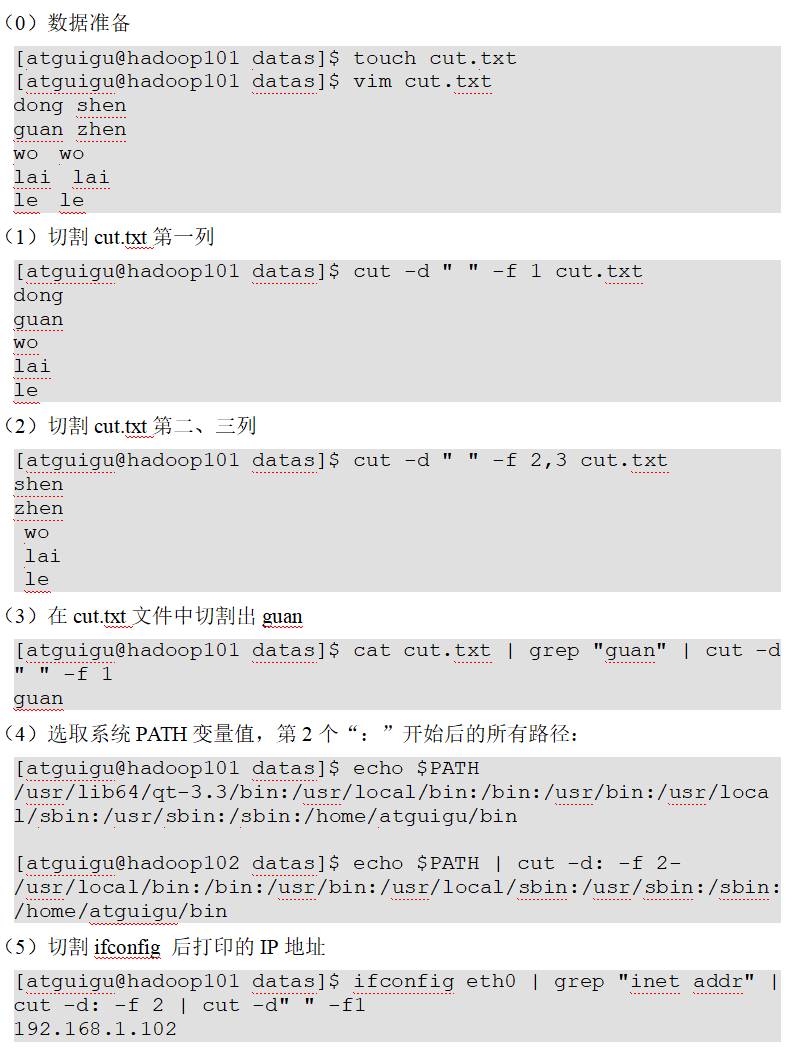
2. sed
sed是一种流编辑器,它一次处理一行内容。处理时,把当前处理的行存储在临时缓冲区中,称为“模式空间”,接着用sed命令处理缓冲区中的内容,处理完成后,把缓冲区的内容送往屏幕。接着处理下一行,这样不断重复,直到文件末尾。文件内容并没有改变,除非你使用重定向存储输出。
1. 基本用法
sed [选项参数] ‘command’ filename
2. 选项参数说明
| 选项参数 | 功能 |
| -e | 直接在指令列模式上进行sed的动作编辑。 |
3. 命令功能描述
| 命令 | 功能描述 |
| a | 新增,a的后面可以接字串,在下一行出现 |
| d | 删除 |
| s | 查找并替换 |
4. 案例实操
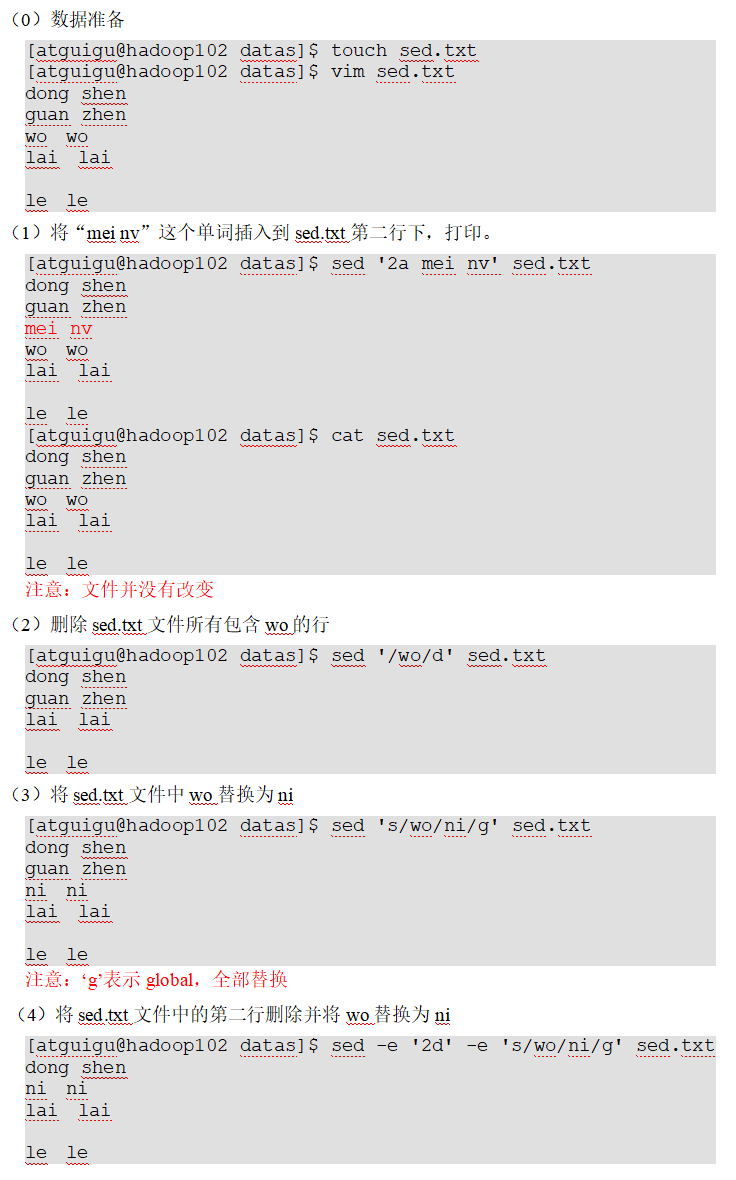
3. awk
一个强大的文本分析工具,把文件逐行的读入,以空格为默认分隔符将每行切片,切开的部分再进行分析处理。
1. 基本用法
awk [选项参数] ‘pattern1{action1} pattern2{action2}...’ filename
pattern:表示AWK在数据中查找的内容,就是匹配模式
action:在找到匹配内容时所执行的一系列命令
2. 选项参数说明
| 选项参数 | 功能 |
| -F | 指定输入文件折分隔符 |
| -v | 赋值一个用户定义变量 |
3. 案例实操
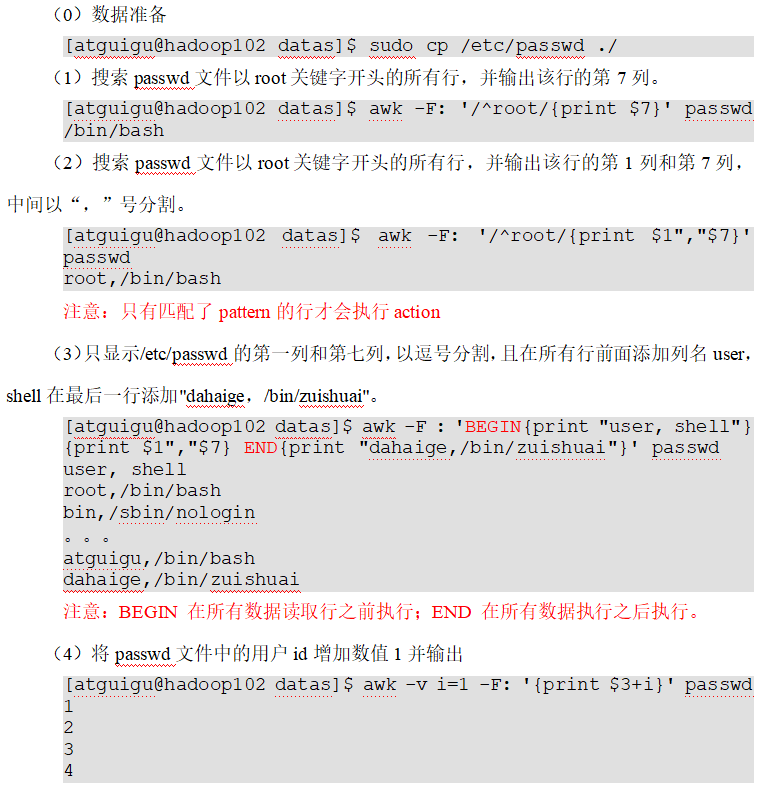
4. awk的内置变量
| 变量 | 说明 |
| FILENAME | 文件名 |
| NR | 已读的记录数 |
| NF | 浏览记录的域的个数(切割后,列的个数) |
5. 案例实操
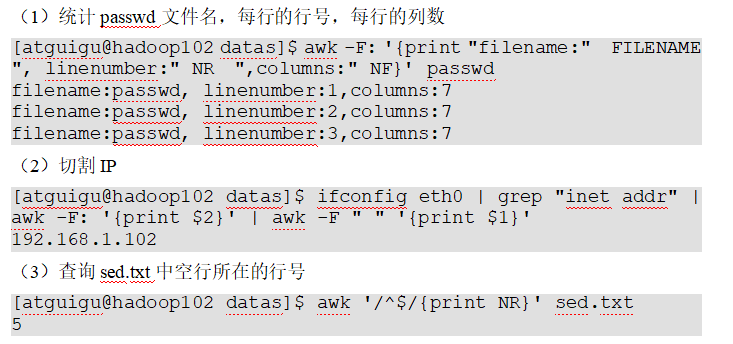
4. sort
sort命令是在Linux里非常有用,它将文件进行排序,并将排序结果标准输出。
1. 基本语法
sort(选项)(参数)
| 选项 | 说明 |
| -n | 依照数值的大小排序 |
| -r | 以相反的顺序来排序 |
| -t | 设置排序时所用的分隔字符 |
| -k | 指定需要排序的列 |
参数:指定待排序的文件列表
2. 案例实操

第11章 企业真实面试题(重点)
1. 京东
问题1:使用Linux命令查询file1中空行所在的行号
答案:
[atguigu@hadoop102 datas]$ awk '/^$/{print NR}' sed.txt
5问题2:有文件chengji.txt内容如下:
张三 40
李四 50
王五 60
使用Linux命令计算第二列的和并输出
[atguigu@hadoop102 datas]$ cat chengji.txt | awk -F " " '{sum+=$2} END{print sum}'
1502. 搜狐&和讯网
问题:Shell脚本里如何检查一个文件是否存在?如果不存在该如何处理?
#!/bin/bashif [ -f file.txt ]; thenecho "文件存在!"
elseecho "文件不存在!"
fi3. 新浪
问题:用shell写一个脚本,对文本中无序的一列数字排序
[root@CentOS6-2 ~]# cat test.txt
9
8
7
6
5
4
3
2
10
1
[root@CentOS6-2 ~]# sort -n test.txt|awk '{a+=$0;print $0}END{print "SUM="a}'
1
2
3
4
5
6
7
8
9
10
SUM=554. 金和网络
问题:请用shell脚本写出查找当前文件夹(/home)下所有的文本文件内容中包含有字符”shen”的文件名称
[atguigu@hadoop102 datas]$ grep -r "shen" /home | cut -d ":" -f 1
/home/atguigu/datas/sed.txt
/home/atguigu/datas/cut.txt